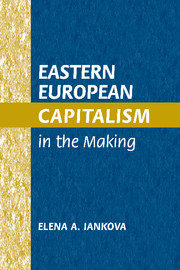Book contents
- Frontmatter
- Contents
- Acknowledgments
- List of Abbreviations
- 1 Hybrid Capitalism in the Making
- 2 The Corporatist Legacy of State Socialism
- 3 Bulgaria's National Tripartism
- 4 National Social Dialogue in Poland
- 5 The Politics of Sectoral Tripartism
- 6 The Politics of Regional Tripartism
- 7 Conclusions: Transiency and Continuity
- Tables
- References
- Index
2 - The Corporatist Legacy of State Socialism
Published online by Cambridge University Press: 30 July 2009
- Frontmatter
- Contents
- Acknowledgments
- List of Abbreviations
- 1 Hybrid Capitalism in the Making
- 2 The Corporatist Legacy of State Socialism
- 3 Bulgaria's National Tripartism
- 4 National Social Dialogue in Poland
- 5 The Politics of Sectoral Tripartism
- 6 The Politics of Regional Tripartism
- 7 Conclusions: Transiency and Continuity
- Tables
- References
- Index
Summary
You can always find more than sufficient causes for every great event — after the event. Certainly there were major structural causes of what happened in 1989. Not the least of these was the widening economic gap between East and West, a gap which detente policies did enable ordinary East Europeans to appreciate and resent. But we must beware of what Henri Bergson called “the illusions of retrospective determinism.” Interpretations that present the events and outcome of 1989 as inevitable are probably further from the truth than we were at the time, in our heady cloud of unknowing.
Timothy Garton Ash, “Ten Years After,” New York Review of Books, 18 November 1999Introduction
World War II left Europe in economic devastation and ruins, both East and West. The immediate postwar years set the stage for the development, however, of two distinct types of corporatism in Western and Eastern Europe. In the West, the postwar settlements among labor, business, and the state embraced a new, nonfascist, democratic brand of corporatism. They established the foundations of a comprehensive social system that peaked in the 1970s, producing remarkable economic miracles on the basis of internal social cohesion and solidarity. In the East, the postwar years of transition to state socialism also encompassed significant adjustments and compromises between society and the state.
- Type
- Chapter
- Information
- Eastern European Capitalism in the Making , pp. 31 - 51Publisher: Cambridge University PressPrint publication year: 2002



